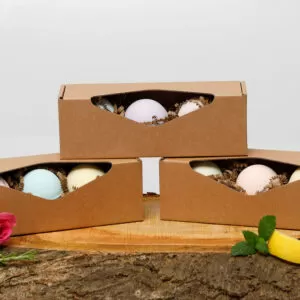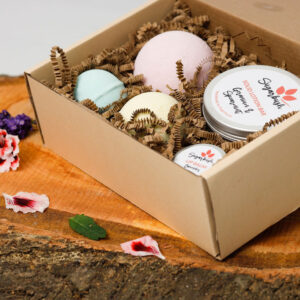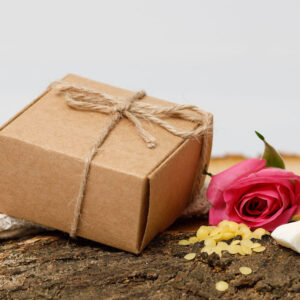If you’ve ever fancied making your own soap but felt put off by handling Lye (Caustic Soda), don’t worry — there’s a simpler, safer way. Melt and Pour soap is ideal for beginners: quick, relatively inexpensive, and hugely satisfying.
Years ago, I did an artisanal soap-making course and loved it. While using Lye was daunting at first, the joy of creating something unique made it worthwhile. These days, though, I often opt for Melt and Pour because it’s so much quicker and easier — perfect for those of us short on time!
In this guide, I’ll show you exactly what you need, where to buy supplies and step-by-step instructions to create beautiful handmade soaps at home.
What you’ll need
Essentials:
• Melt and Pour Soap Base

• Plastic chopping board
• Old knife
• Scales
• Silicone soap moulds
• Glass Pyrex jug
• Silicone spatula
• Essential oils of your choice

• Microwave or double boiler (pan of water on a stove!)
• 70% isopropyl alcohol
• Small spray bottle for alcohol
• Baking trays
• Greaseproof paper
Important Note: Always keep separate equipment for making cosmetics to avoid contaminating food items.
Optional Extras:
• Natural mica for colour and sparkle
• Natural loofah rounds
• Pumice granules
Where to buy supplies
Your local supermarket will cover most basics (jug, spatula, chopping board, knife, scales). Online is great for specialist items:
• Amazon:
o 3-pack of loofah rounds — around £6.99, enough for nine soap rounds.
o Silicone moulds in endless shapes and sizes.
• The Soapery (https://www.thesoapery.co.uk):
o Soap bases https://www.thesoapery.co.uk/collections/melt-and-pour-soap-bases
o Essential oils https://www.thesoapery.co.uk/collections/essential-oils. They sell most of their oils in 10ml bottles, perfect for small batches.
o Mica powders https://www.thesoapery.co.uk/collections/mica-pigments
o Soap moulds https://www.thesoapery.co.uk/collections/silicone-moulds
• Naturally Thinking (https://naturallythinking.com):
o Essential oils https://naturallythinking.com/essential-oils/
Step-by-step soap-making guide
1. Prepare your workspace – Decant some alcohol into your spray bottle. Then, disinfect all equipment and surfaces by spraying with Isopropyl Alcohol. Let everything dry before starting.
2. Set up moulds – Line baking trays with greaseproof paper and place your silicone moulds on top. This makes it easier to move your soaps while they are setting.
3. Measure and cut soap base – Remove the soap base from its container (loosen edges with a knife if needed). Cut the block into small chunks about 2cm. Using your scales, measure out four equal piles of 250g.
4. Melt – Place 250g into a glass jug. Microwave in 30-second bursts, stirring each time, or use a double boiler. If using the double boiler method, stir your soap base periodically and ensure the water in the pan doesn’t boil dry.
5. Cool slightly – Once completely melted, allow the base to cool slightly before adding fragrance (essential oil).
6. Add Fragrance – Add up to 50 drops of essential oil per 250g of base. If you want to be precise, aim for no more than 1% essential oil by weight — about 2.5g – but you’ll need jewellery scales to get an accurate measure. When starting out, it’s best to stick to a single essential oil while you build your confidence. Mix thoroughly.
7. Pour and set – Pour into moulds. Leave to set — overnight is best.
8. Unmould and store – Remove soaps from moulds and store in an airtight container.
9. Enjoy! Your hand-crafted soaps are ready to use or give as gifts.
Troubleshooting tips
Moisture collecting on bars
Melt and Pour soap contains glycerine, a natural humectant that draws moisture from the air. It’s harmless and won’t impact it’s efficacy. To reduce this, wrap soaps in cling film or, for an eco-friendlier option, try beeswax wraps.
Bubbles after pouring
If you see bubbles on the surface after pouring, lightly spritz with Isopropyl Alcohol using a spray bottle. This helps achieve a smooth, professional finish.
Creative Variations
Once you’ve mastered the basics, try these ideas:
• Add natural Mica: A little adds gorgeous colour and shimmer.
• Layering: Pour two batches with different colours or fragrances for striped soaps. You can even add swirls!
• Embed Loofah: Place a loofah round in your mould before pouring for exfoliating bars. Loofah normally comes flat. Before use, rehydrate in water and allow to dry. You can then cut your rounds to fit your soap moulds.

• Add Pumice granules: Mix pumice into the melted base for a natural exfoliating soap. (Note: pumice may settle at the bottom of the mould.)
Final thoughts
Making soap at home doesn’t have to be complicated. Melt and Pour is a brilliant way to experiment with scents, colours and textures without the fuss of traditional soap-making methods.
If you give it a try, I’d love to see what you create! Feel free to share your results with me over on Facebook @sugarbushuk or Instagram.






